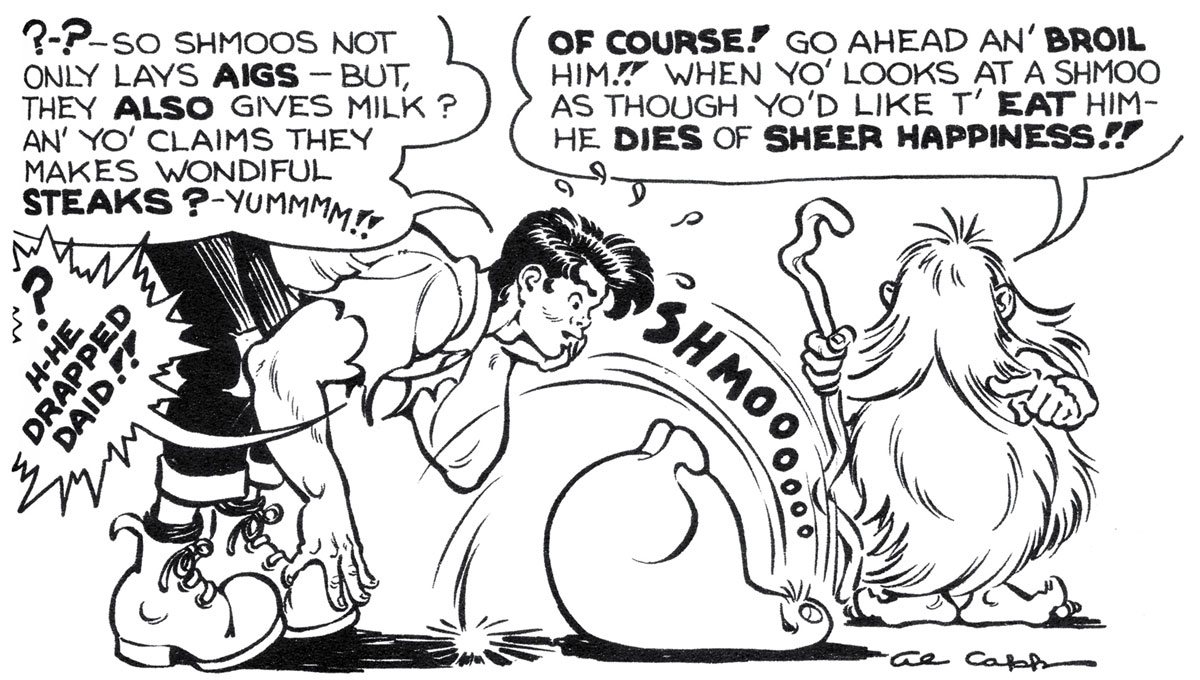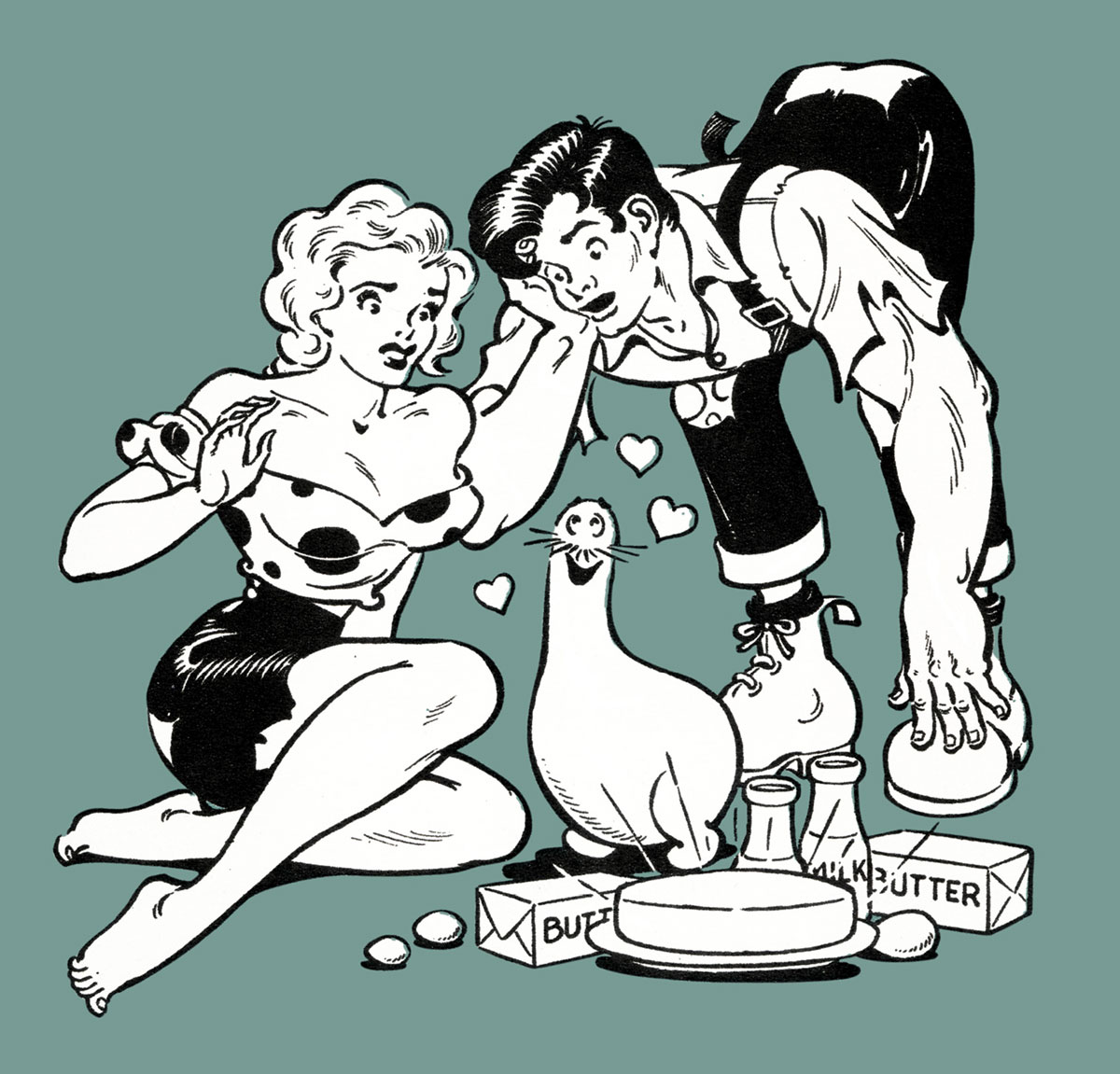Ingestion / Dialectics of the Shmoo
The Eucharist of utopia
Yara Flores
“Ingestion” is a column that explores food within a framework informed by aesthetics, history, and philosophy.

I take as my text Al Capp’s 1948 The Life and Times of the Shmoo, the book-form reprinting of Capp’s original sequence of L’il Abner cartoons that, starting in August of that year, introduced American newspaper readers to the friendly, soft, colorless, gourd-shaped creature called the Shmoo.
A little context: the caustic, well-read, one-legged Capp (born Alfred Caplin, to a family of Russian Jewish descent then resident in New Haven, Connecticut) was, by 1948, a national figure on account of more than a decade of sardonic, exuberant, and irreverent cartooning. His nationally syndicated L’il Abner strip—depicting the hillbilly antics of the dirt-poor residents of Dogpatch, USA—had upwards of thirty million daily readers in the immediate postwar years, a number that would double in the decade to come. A febrile eroticist (whose work exudes an odor of adolescent incontinence), a savage social critic (whose indiscriminant satires convey something of the thin misanthropy of the crank), and a celebrity controversialist (whose clowning, camera-loving truculence foreshadowed features of our current media climate), Capp is an acquired taste. And it tastes a great deal like the 1950s. Steinbeck thought he was the greatest writer in America; that right there may say it all. An admiring Updike called it all “Voltairean.” One encounters allusions to Rabelais. Perhaps.
My Capp misgivings aside, it cannot be denied that the Shmoo represents a satirical conjuration of Swiftian proportions. Waylaid in the woods, the strip’s eponymous hero (L’il Abner himself, a hunkish lout of good heart and little mind), stumbles upon the Valley of the Shmoo (guarded by a buxom Amazon, but never mind), where he discovers these impossibly friendly critters, whose unique desire, it would seem, is to give themselves up for human happiness. They lay eggs, give milk, and their flesh is sweet, approximating chicken when fried and steak when broiled. They are wholly boneless, reproduce every few minutes (apparently asexually, but I will return to this), and require zero upkeep. Most peculiarly expressive of their appetite for service, as L’il Abner soon discovers, is their propensity to die, spontaneously, when looked at with hunger. Overcome by affection for its new friend, one Shmoo lays a cheesecake.
The unfolding plotline brings out the critical edge of this fantasy creature from the land of Cockaigne: L’il Abner introduces the Shmoos to Dogpatch, where they instantly wreck the system of exploitative capitalism under which the Dogpatchers live. The bloodsucking grocer is bankrupted (yes, ugly anti-Semitic gestures are made here). The pork baron sees ruin on the horizon. The factory industrialists cannot find wage labor. As this “plague” of plenty spreads across the country, the forces of reaction seize upon the magnitude of the crisis, hiring an army of toughs to exterminate the Shmoos. In which they are nearly successful: the Dogpatchers preserve two, male and female, and sequel dramas hinge on the question of restoring the race (note the contradiction with Capp’s presentation of the Shmoo as reproducing via spontaneous “budding”—this is never worked out).
That a “Shmoo Craze” swept the nation between 1948 and 1952 is elsewhere documented. The creatures and their creator made the cover of Time magazine. Facsimile Shmoos were mobilized in the Berlin Airlift. Shmoo licensing and products raised staggering sums of money, upwards of twenty-five million (1948) dollars.

What concerns me here, however, is a brief resumé of the critical uses of the Shmoo. Predictably, the left has seen in The Life and Times of the Shmoo a visionary parable of the contradictions of capitalism. In his valuable Class Counts, the distinguished Marxist sociologist Erik Olin Wright (building on a suggestion by the British philosopher G. A. Cohen) elaborates the core principles of historical materialism using the Shmoo, reading L’il Abner to explicate class interest and formally define exploitation. Surprisingly, perhaps, others have interpreted the story the other way around, with Gary Wills, for instance, seeing in the Shmoos a send-up of progressive social policies—a reading, in my view, difficult to square with Capp’s own Shmoo glosses from the late 1940s, which are pastoral in the extreme, and possess something of the agrarian romanticism of early E. P. Thompson (e.g., Capp on the inspiration for the Shmoo: “the earth … it’s eager to give us everything we need”). It is notoriously the case, however, that Capp did meander to the right across the 1960s, emerging as a strident hippy-basher and paleo-conservative. He may well have repurposed the Shmoo across his own political evolution.
Although Capp himself made at best a middlebrow feminist (and probably not even that), there have been a few sympathetic gender-readings of the Shmoo (key evidence: one of the original cartoons depicts a showgirl no longer required to entertain her beau for a decent meal). Wright himself notes in passing that housewives are, from a patriarchal microeconomic perspective, the original “Shmoo”—a something for nothing. On the other hand, considerably more arresting is Greta Gaard’s suggestion that, in light of Carol J. Adams’s The Sexual Politics of Meat, the Shmoo must be understood as nothing less than carnivore porn: just as pornography norms rape as the apotheosis of female desire, the Shmoo’s self-immolation whitewashes the grotesque violence of the abattoir with a fantasy of meat-jouissance.
Shades of Bataille. And it is here, I think, that we come to crux of the matter. Political-economic readings of the Shmoos overlook—perhaps because they must—the exquisite act of incandescent, spontaneous, erotic autolysis that lies at the real center of the Shmoos’ transgressive power: they are literally consumed by love. They die of desire to feed their flock. This is self-sacrifice as transcendence—the absolute unspeakable of rational analysis, if also the perennial matrix of human community.
The Shmoo: materia prima of the social body; the Eucharist of utopia.
Yara Flores is a designer and illustrator who writes on the history of visual culture and media. Originally from Brazil, she now lives in Puerto Rico.